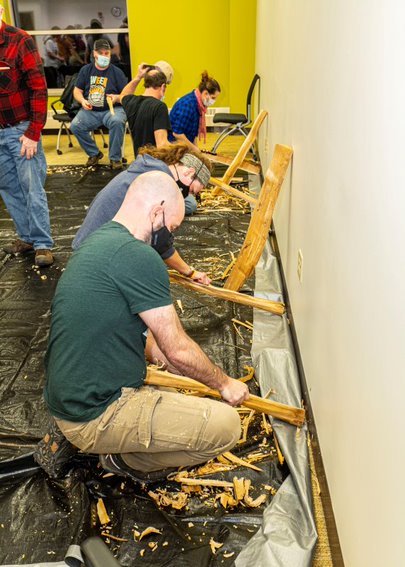
A River Talk participant forms a wild rice knocker into shape during the March talk. Image credit: Michael Anderson
The River Talk for March was held as an evening in-person event during the 12th annual St. Louis River Summit at the University of Wisconsin-Superior.
This particular talk required hands-on participation. Marne Kaeske, cultural preservation specialist with the 1854 Treaty Authority, led an activity where attendees constructed their own wild rice harvesting sticks, called, “Bawa’iganaakoog” in Ojibwe. Wild rice is a grass that can grow to reach 8 feet tall.

River Talkers use the wall to brace their work on wild rice knocking sticks. Image credit: Michael Anderson
Kaeske explained that she learned to make rice knockers from cedar because the wood is lightweight. Rice is harvested by two people. One paddles or push-poles the canoe through the wild rice (manoomin) beds found in wetlands while the other uses the sticks to bend the rice over the canoe, tapping the wild rice seeds into it. Hand-harvesting wild rice can be time-consuming, so the lighter the sticks, the less tired a ricer’s arms will get.
Different resource management agencies have different requirements for the length of wild rice sticks. Kaeske said current 1854 Treaty Authority Ceded Territory Code regulations call for “round, smooth cedar, no longer than 32-inch” sticks. In Wisconsin, they can be 38 inches.
One problem in efforts to preserve wild rice beds comes from people harvesting the rice too early. “We live by the clock and the calendar nowadays instead of by waiting and living on the rice lake until it’s time to rice,” Kaeske said. When people harvest the rice before it is mature, it lessens the good seed for the next year’s crop and can damage the plants.
“When you harvest wild rice, you’re also reseeding the lake,” Kaeske said. “Rice is an annual plant.”
Rice knockers aren’t something a person can buy in a store. Kaeske showed the audience how she learned to do it. After a short introduction, she offered the tools needed (measuring tape, planers and an ax) and let participants “go to town” on the wood she provided.
She explained that all the bark needs to be removed as well as any rotten wood. The sticks are usually tapered, larger where the hand grips and smaller on the ends.
By the end of the class, everyone had sticks to take home and they were ready for ricing season, which usually occurs in late summer or early fall.
The remaining River Talks for this season will be held April 13 and May 11. For more information, visit the River Talks page: go.wisc.edu/4uz720.


